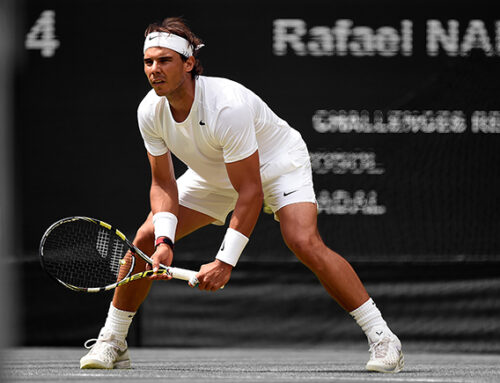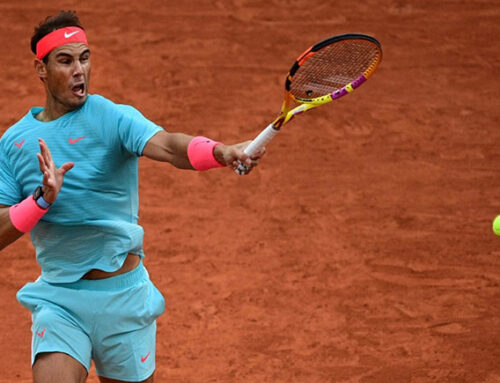How Has Federer’s Forehand Changed?
Things Change
There’s an old adage that if you’re not getting better, you’re getting worse. This is predicated on the idea that someone out there is improving, and if you stay the same while others get better then relative to the field you’re losing ground. When we look at most professional tennis players, we see changes in their game over time. In some instances, these things are the result of intentional work such as Andy Roddick’s slice backhand while working with Larry Stefanki. Sometimes it’s a result of injuries. Sometimes however things just shift gradually over time, change without intent. In these instances the changes tend to be gradual, and not always beneficial. This is actually the third article in the Finding Federer series, which looks at some aspects of Federer’s game that have changed for the worse over the last 12-14 years of his professional career. The first article simply looked at defining his decline in terms of results – exactly when was Federer’s peak period? The second article examined an area where Federer’s tactical acumen waned, and he moved away from some highly successful patterns particularly around the slice backhand. This time we look at the forehand, and how it has shifted from being perhaps the most potent and beautiful stroke in the history of the sport to being… well, just exceptionally good.
Evolution or Devolution?
In many ways explaining the technical changes in Federer’s forehand is incredibly difficult. One of the things that has made it such an amazing stroke over the course of Federer’s career is how beautifully it adapts to different situations and scenarios. The range of options Federer has available on that wing, means that in two identical circumstances he might hit four or five different variations ranging from Nadal-level topspin, to del Potro-level power (and everything in between). In Federer’s case it is difficult to imagine the changes which have occurred were the result of intentional work. Rather, they have come about gradually over time as result of a lack of intention. In not working specifically to maintain the precise technique, small elements of which have been lost or changed with the millions of repetitions and sheer volume of match-play. Over the same span of years in which we have seen Federer’s serve improve through targeted work, his forehand has suffered a decline. Anyone doubting this should look at matches during the 2004-5 seasons especially, and compare the forehands seen there with those from 2009 onwards. When we account for small losses in Federer’s movement, the reduction in forehand performance is still there to be seen.
Side By Side
In all of the images shown blow, the forehands Federer are hitting are virtually identical shots some 4-6 years apart. He is using similar movement patterns, hitting a ball that has approximately the same contact height, in the same direction with the same type of shot. These are straight up apples-to-apples comparisons!
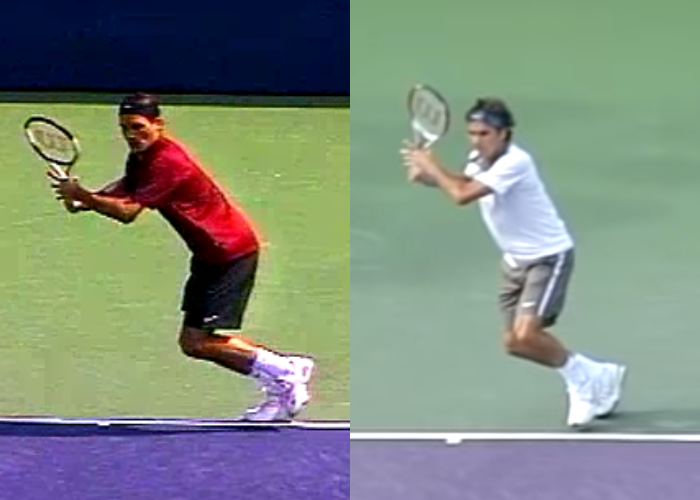
This is the first image in a sequence that compares two essentially identical forehands of Federer’s. On the left (red shirt) we have a running forehand from 2004. On the right is the exact same shot hit in 2009. We can see even in this first frame that there are some differences. In 2004, Federer’s right arm is extended slightly further away from his body as a part of his initial turn. Also important is the difference in the racquet head angles between the two strokes. In 2009, the racquet head is leaning in towards Federer’s body, whereas in 2004 it is actually leaning slightly outwards. Even just this difference will result in an impact later on in the stroke.
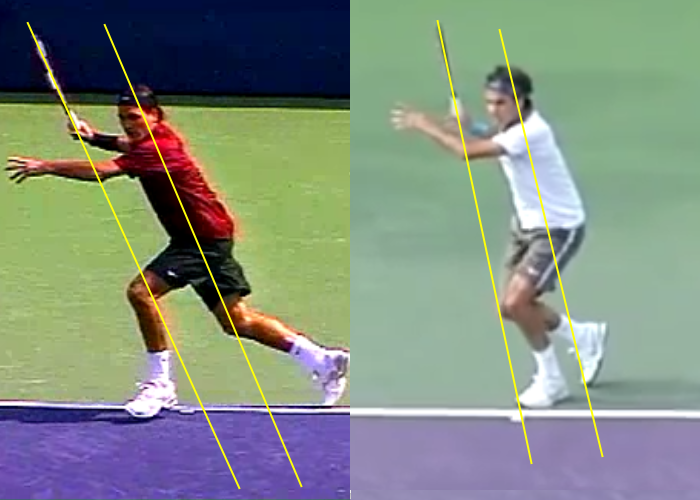
In this second frame we can again see subtle differences. The right arm is still extended further away in 2004 as compared to 2009. In the 2004 stroke we can see Federer’s upper body is leaning over slightly more than in 2009, but this is related to stride length. Importantly though, the angle of racquet-head to upper body is different. In 2004, Federer’s racquet head is angled outwards by about 1.3 degrees. In 2009, it is angled inwards by 1.5 degrees. To the casual observer, this 2.8 degree shift might seem absurdly small, but the reality is that it has biomechanical consequences. The wrist engagement will be different between these two strokes, as will the total travel distance of the racquet head. In 2004 the stroke is more expansive.
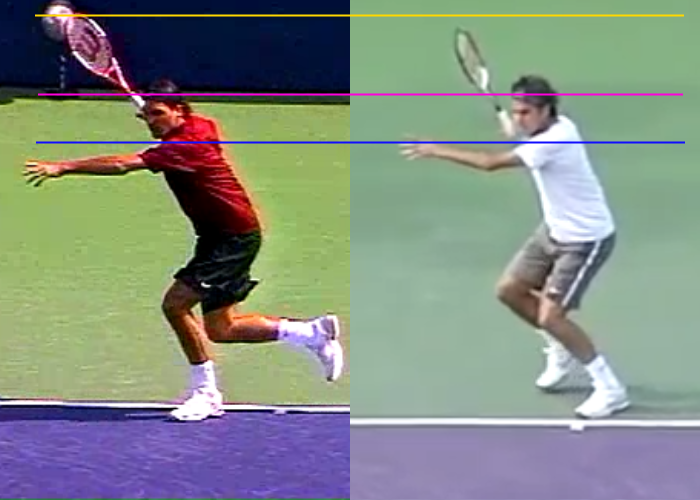
At this point in the technique we begin to see the cumulative effects of those small variations in the previous imagery. As shown by the colored lines, in 2004 Federer’s right hand is extending further back into the space behind the court. Additionally it is higher relative to the shoulders. The racquet head is both leaning further away from Federer’s body, and also leaning more towards the net. In 2009 the stroke is more contracted. The hand is closer to the body, and lower relative to the shoulders. The racquet is in a more compact position, with less lean in both planes.
Subtly Consistent
Given the variability of Federer’s forehand, his ability to scale the stroke depending on a dozen factors, one forehand is not enough evidence to say this is a definitive change. Given this more proof was required!
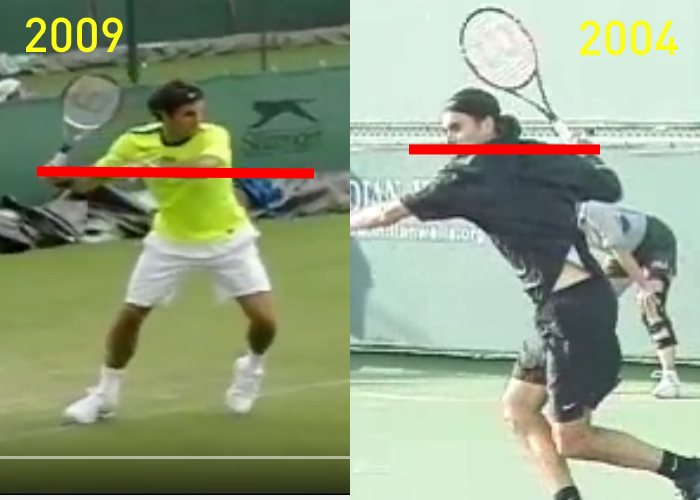
These two strokes are from 2004 and 2009, and were virtually identical in terms of the type of stroke. Again we can see that at this point in the swing, Federer’s right hand was shoulder-height in 2004 and the arm was extending well into the space behind the court. In 2009, things are more compact, with the hand dropped significantly and the racquet head proportionally lower.
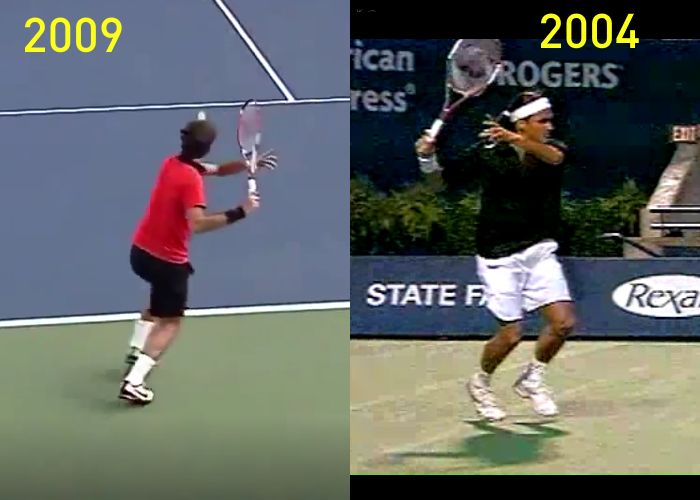
We see the same patterns setting up here, particularly relating to the height of the right hand and the racquet head.
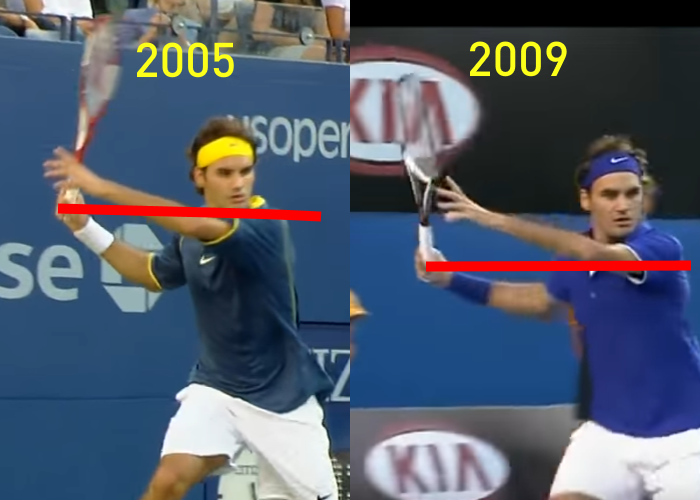
This image was particularly compelling, as the two shots were taken from the same angle, in the same hitting stance attempting the same shot (albeit more than four years apart). Again we see the right hand of Federer is lower in 2009 than in 2005, and the racquet head is then also lower.
What Impact Does This Have?
If we can all accept that this general trend has taken place, the next question is: what impact does this have? The most obvious outcome is that Federer’s backswing has become shorter over time. Federer’s hand drops into a lower position earlier, and he keeps the racquet head closer to his body. This means as he continues back behind the body the backswing reduces in size.
If you listen to many coaches out there, having a more compact backswing is a good thing, right? Right? For some players, it might be. For world-class athletes who are trying to maximize biomechanical performance, there absolutely is such a thing as ‘too compact’. When we think of most of the best forehands in the modern history of the sport (Fernando Gonzalez, Roger Federer, Juan Martin del Potro) they have a large backswing in common.
Larger backswings are important for a couple of reasons.
1. They allow more power. The longer the racquet is accelerating, the faster it is going when it reaches contact.
2. They allow more ‘smoothness’. Acceleration while changing direction happens on a curve. Longer backswings allow a smoother stroke path, which means more reliable timing and better biomechanics.
We might notice that beginning around 2009 we began to see more and more mishit forehands from Federer. Indeed some of his shanks have been epic – balls catapulted high into the stands if not out of the stadium altogether. As Federer’s backswing became more compact, it lost a little of the smoothness that made it such a beautiful stroke to observe. Pair this with the incredible acceleration he incorporates and suddenly you have a recipe for increased mishits.
Conclusion
Isolating small, subtle changes such as this can be hard. During the same period that we’ve seen Federer’s stroke slowly change, we’ve also seen other changes in his game. Federer’s serve has continued to improve. His volleys have become sharper, and his tactics have also evolved. At the same time Federer’s movement has also declined slightly – he hasn’t quite the speed he once had. Federer’s forehand has changed, however subtle those differences might be to the naked eye. To the vast majority of players and fans, a few degrees in takeback angle, and a handful of inches (or centimeters) in hand position might seem negligible. For a world-class performer such as Federer however these tiny differences make the world of difference. While we are unlikely to see Federer’s forehand revert to its 2004 edition, it remains a formidable stroke among the best in the sport.
